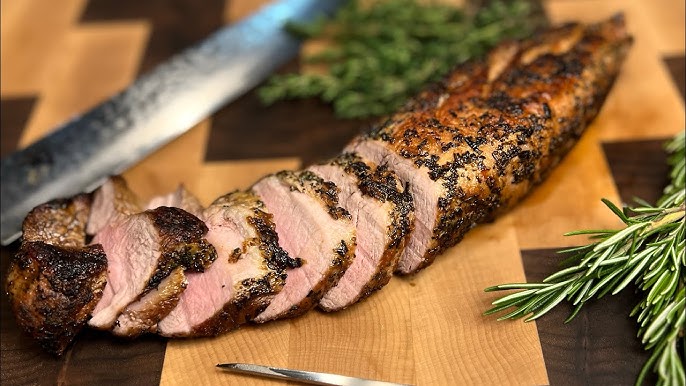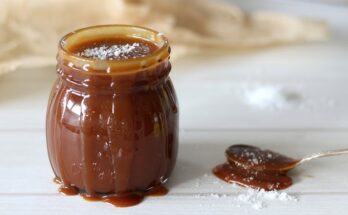Roasted Pork Loin Recipe: Roasted pork loin is one of those underrated dishes that can turn an ordinary dinner into a flavorful feast. It’s a perfect balance between rich flavor and lean meat, making it a healthier alternative to pork shoulder or ribs, yet still juicy and delicious. Whether you’re preparing a weeknight meal or hosting a dinner party, roasted pork loin fits the bill every single time.
Why Pork Loin is a Perfect Roast
Why is pork loin such a fantastic choice? Well, it’s all about the cut. Pork loin is a boneless, lean cut that comes from the back of the pig. It’s tender when cooked correctly and has just enough fat to create a crispy, golden-brown crust when roasted. You don’t need to fuss over it too much either. Once it’s seasoned and placed in the oven, it does most of the work itself.
Unlike pork tenderloin, which is thinner and requires quicker cooking, pork loin benefits from a longer roast at a moderate temperature. This allows the meat to cook evenly, soaking in all the flavors of herbs, spices, and any additional ingredients you’ve added.
What also makes it special is its versatility—you can go classic with garlic and rosemary or spice things up with a honey mustard glaze. It’s like a blank canvas for flavor lovers.
Ideal Occasions for Serving Pork Loin
This dish shines on so many occasions. Hosting Thanksgiving but want something other than turkey? Roast pork loin. Want to impress your in-laws? Roast pork loin. Need an easy Sunday dinner that makes the house smell like heaven? You guessed it.
It’s perfect for:
- Holiday meals (Christmas, Easter, Thanksgiving)
- Sunday family dinners
- Dinner parties
- Meal prep for the week
Plus, pork loin slices beautifully, making for elegant presentation and great leftovers for sandwiches or wraps.
Ingredients You’ll Need
Great recipes begin with great ingredients. And when it comes to roasted pork loin, using fresh, high-quality components can take this dish from good to unforgettable.
Main Ingredients
Here’s a solid list of what you’ll need for a basic, flavorful roast pork loin:
- 3–4 lb pork loin (boneless)
- 2 tablespoons olive oil
- 4 cloves garlic, minced
- 1 tablespoon fresh rosemary, chopped (or 1 tsp dried)
- 1 tablespoon fresh thyme (or 1 tsp dried)
- 1 teaspoon onion powder
- 1 teaspoon paprika (optional, for color)
- 1 teaspoon salt
- ½ teaspoon black pepper
These core ingredients provide a well-balanced, aromatic flavor. Garlic and herbs make the pork taste fresh and savory, while paprika adds a lovely golden crust.
Optional Add-ins for Extra Flavor
Want to elevate your pork loin even further? Try these optional add-ins:
- Dijon mustard or honey mustard (for a glaze)
- Balsamic vinegar or apple cider vinegar (for brightness)
- Sliced apples or pears (for sweetness)
- Onion wedges or shallots (for depth)
- A splash of white wine or chicken broth (for moisture in the pan)
These additions don’t just add taste—they create an incredible aroma and a bit of sauce to drizzle over the sliced meat later.
Choosing Quality Pork Loin
When shopping for pork loin, try to choose:
- Fresh, not frozen cuts if possible.
- Evenly sized, rectangular-shaped loins to ensure even cooking.
- Natural or organic pork if budget allows—it’s often more tender and flavorful.
- Fat cap on top (a thin layer of fat) can be a bonus for flavor, but avoid overly fatty cuts.
Avoid pre-seasoned or brined pork loin if you want to control the salt content and flavor profile of your recipe.
Kitchen Tools and Equipment Required
You don’t need a fancy setup to make roasted pork loin, but having the right tools definitely helps ensure great results.
Essential Cooking Tools
- Oven-safe roasting pan or baking dish: Deep enough to catch juices.
- Meat thermometer: Non-negotiable. It ensures you don’t overcook the roast.
- Sharp chef’s knife: For slicing and trimming the pork.
- Cutting board: Preferably with grooves to catch meat juices.
- Tongs: For turning the roast if you’re searing.
- Foil: For tenting the roast as it rests.
Optional Gadgets That Make It Easier
- Cast iron skillet: Ideal for searing and oven use.
- Baster or spoon: For drizzling juices back on the roast mid-cook.
- Silicone brush: If you’re applying glaze.
- Digital timer or smart oven features: Helpful for timing the roast precisely.
You probably already have most of these tools in your kitchen. But if you’re serious about roasts, investing in a digital meat thermometer is worth every penny. Pork loin can go from perfect to dry in a matter of minutes—precision matters!
Preparing the Pork Loin
A well-prepared pork loin sets the foundation for a flawless roast. Don’t rush this part—proper preparation adds layers of flavor and ensures even cooking.
Trimming and Cleaning the Meat
Start by rinsing the pork loin under cold water and patting it completely dry with paper towels. Moisture on the surface can prevent a good sear and make it harder for seasonings to stick.
Next, inspect the meat for any silver skin, which is a tough, silvery membrane that doesn’t break down during cooking. If you spot it, use a sharp knife to gently slide under and remove it. Leaving a bit of fat on top is fine (and delicious) as it bastes the meat while roasting.
Trim any excess fat hanging over the sides but avoid trimming too much from the top. A thin fat layer helps keep the meat juicy.
Marinating Tips and Tricks
While a full overnight marinade is optional, even a 30-minute flavor soak can make a difference. Here’s a simple garlic-herb marinade:
Simple Marinade:
- 3 tbsp olive oil
- 4 garlic cloves (minced)
- 1 tbsp rosemary
- 1 tbsp thyme
- 1 tsp salt
- ½ tsp pepper
Rub the marinade all over the pork, making sure it gets into every nook and cranny. You can marinate in a large Ziploc bag or a sealed container. If you’re short on time, apply a dry rub just before cooking—still great results!
Let the pork sit out at room temperature for about 20–30 minutes before cooking. This helps it roast evenly and keeps the center from staying cold and underdone.
Step-by-Step Guide to Cooking Roasted Pork Loin
So now that your pork loin is prepped and marinated, it’s time to cook this beauty! Follow these step-by-step instructions to ensure a perfectly roasted pork loin every time.
Step 1: Preheat and Prep
Start by preheating your oven to 375°F (190°C). Pat the pork loin dry with paper towels — this helps it roast beautifully instead of steaming. Rub it generously with olive oil, salt, pepper, minced garlic, and herbs like rosemary or thyme. For a touch of sweetness, you can add a drizzle of honey or a sprinkle of brown sugar. Place the seasoned pork on a rack in a roasting pan to allow heat to circulate evenly.
Step 2: Searing the Pork (Optional)
For extra flavor and a golden crust, sear the pork loin before roasting. Heat a skillet over medium-high heat with a bit of oil, and brown the pork on all sides for about 2–3 minutes per side. This caramelizes the surface, sealing in juices and adding that irresistible depth of flavor.
Step 3: Roasting to Perfection
Transfer the pork to your preheated oven and roast for 20–25 minutes per pound, or until the internal temperature reaches 145°F (63°C). Baste the roast occasionally with its own pan juices to keep it moist and flavorful. For added aroma, toss a few garlic cloves or onion slices into the pan while it cooks.
Step 4: Resting the Roast
Once fully cooked, remove the pork loin from the oven and tent it loosely with foil. Let it rest for 10–15 minutes before slicing. This step allows the juices to redistribute throughout the meat, ensuring every slice stays juicy and tender.
Step 5: Slicing and Serving
Slice the pork loin into even, thick pieces using a sharp knife. Serve it warm with a side of roasted vegetables, mashed potatoes, or a light apple or mustard sauce. The result? A perfectly roasted pork loin that’s juicy inside, golden outside, and absolutely bursting with flavor.
Delicious Side Dishes to Serve with Pork Loin
A well-roasted pork loin deserves equally delicious sidekicks. The right sides can balance the richness of the pork and complete the meal beautifully.
Classic Potato and Veggie Sides
You can’t go wrong with the classics—here are some top picks:
- Garlic Mashed Potatoes
Creamy, buttery, and smooth. The richness complements pork beautifully, especially when paired with pan gravy. - Roasted Root Vegetables
Toss carrots, parsnips, and sweet potatoes with olive oil, salt, pepper, and rosemary. Roast them alongside the pork for a low-effort, high-impact side. - Green Beans Almondine
Lightly sautéed green beans tossed with butter, toasted almonds, and lemon zest for a fresh, crunchy contrast. - Buttered Corn on the Cob
Sweet, juicy corn pairs so well with the savory pork roast. - Crispy Roasted Brussels Sprouts
A little char, some salt, and a bit of balsamic glaze—perfection.
Sauces and Gravies That Pair Well
Elevate your dish with one of these sauce ideas:
- Apple Cider Gravy: Sweet, tangy, and aromatic. Simmer pan drippings with apple cider, a splash of cream, and cornstarch slurry.
- Garlic Herb Butter Sauce: Melt butter with garlic, thyme, and rosemary—drizzle generously over sliced pork.
- Dijon Mustard Cream Sauce: A mix of Dijon, cream, and chicken stock—rich, tangy, and indulgent.
If you love a fruit-meat combo, try:
- Cranberry chutney
- Peach compote
- Apple and onion relish
These sauces not only taste amazing but add gorgeous color and contrast to your plate.
Storing and Reheating Leftovers
Don’t let your delicious roasted pork loin go to waste! Storing it properly means you can enjoy flavorful leftovers for days—and they can be just as tasty as the first serving if handled right.
Proper Storage Techniques
First, let the pork loin cool to room temperature—but don’t leave it out for more than 2 hours to avoid bacterial growth.
Then, you have two main storage options:
1. Refrigeration:
- Place sliced or whole portions of pork loin in an airtight container.
- Alternatively, wrap the slices tightly in plastic wrap or foil, then place them in a sealed container or zip-top bag.
- Refrigerated pork loin lasts up to 4 days.
2. Freezing:
- For longer storage, freezing works great. Wrap tightly in plastic wrap, then again in foil, or use a vacuum-sealer if you have one.
- Store in a freezer-safe bag or container labeled with the date.
- Frozen pork loin can be stored for up to 3 months.
- To reheat, thaw in the refrigerator overnight before warming.
Reheating Without Losing Moisture
The biggest mistake people make? Overheating leftovers until they turn dry and chewy. Here’s how to reheat like a pro:
In the Oven:
- Preheat to 325°F (163°C).
- Place pork slices in a baking dish, add a splash of broth or leftover juices.
- Cover with foil and heat for 10–15 minutes until warmed through.
On the Stovetop:
- Use a nonstick skillet over low heat.
- Add a tablespoon of water or broth and cover with a lid.
- Warm gently for a few minutes on each side.
In the Microwave:
- Only use this if you’re in a hurry.
- Place pork in a microwave-safe dish with a splash of liquid.
- Cover with a damp paper towel and heat in short bursts (30–45 seconds) to avoid overcooking.
Leftover pork loin is also excellent for sandwiches, tacos, stir-fries, or even chopped into soups or fried rice.
Common Mistakes to Avoid
Even though pork loin is easy to cook, there are a few pitfalls that can mess up your roast. Let’s go over some common mistakes and how to avoid them.
Overcooking or Undercooking
Overcooked pork becomes dry, tough, and flavorless. Undercooked pork is unsafe to eat. The solution? A meat thermometer. Seriously, it’s your best friend in the kitchen.
Remember:
- Target internal temp: 145°F (63°C) for juicy, slightly pink pork.
- Always check the thickest part of the meat.
- Don’t guess based on time alone—ovens vary, and pork loin thicknesses differ.
Also, don’t forget the carryover cooking effect—your pork will continue to cook slightly after it’s removed from the oven.
Skipping the Resting Time
This mistake is more common than you think, especially when you’re hungry or in a rush. But slicing into your pork loin too soon can ruin the entire texture.
Why resting matters:
- Juices redistribute through the meat.
- The texture becomes smoother and more tender.
- It’s easier to slice cleanly.
Rest your pork for at least 10–15 minutes under foil. You can even use that time to prepare side dishes or a quick sauce.
Nutritional Information
If you’re watching what you eat, you’ll be happy to know that roasted pork loin is a healthy choice compared to fattier cuts of pork or red meats.
Caloric Breakdown
Here’s a rough estimate of the nutritional content per 4 oz (113g) serving of plain roasted pork loin (without glaze or sides):
| Nutrient | Amount |
|---|---|
| Calories | ~200 kcal |
| Protein | 26–28g |
| Fat | 8–10g |
| Saturated Fat | ~2.5g |
| Carbohydrates | 0g |
| Fiber | 0g |
| Sugar | 0g |
| Cholesterol | ~75mg |
| Sodium | Depends on seasoning |
Pretty lean, right? That’s why pork loin is a favorite for high-protein, low-carb diets like Keto, Paleo, or Whole30 (as long as you skip sugary glazes).
Health Benefits of Pork Loin
- High in protein – Great for muscle repair and satiety.
- Low in carbs – Ideal for low-carb eating plans.
- Rich in B vitamins – Especially thiamine, niacin, and B6.
- Source of minerals – Like selenium and zinc, which support immunity and metabolism.
When cooked without excessive oil or sugar, pork loin is a clean, satisfying protein choice. Add veggies and you’ve got a balanced meal.
FAQs about Roasted Pork Loin Recipe
1. How do I keep pork loin from drying out?
Use a meat thermometer and don’t overcook it. Let it rest before slicing, and baste with juices during cooking to maintain moisture.
2. Can I use frozen pork loin for this recipe?
Yes, but be sure to thaw it completely in the refrigerator before seasoning or cooking for even results.
3. What’s the best way to add flavor?
Marinate or dry rub with garlic, herbs, and olive oil. A glaze made from mustard, honey, or balsamic vinegar adds extra depth and a tasty crust.
4. Can I cook pork loin in a slow cooker instead?
Absolutely. Brown the pork first, then cook on low for 6–8 hours with broth, onions, and seasonings for a tender, pull-apart version.
5. What wine pairs well with roasted pork loin?
A dry white like Chardonnay or a light red like Pinot Noir pairs beautifully. The wine should complement the dish without overpowering it.
Final Thoughts
Roasted pork loin is one of those dishes that makes you look like a culinary pro—even if you’re just winging it in your kitchen. With its tender texture, rich flavor, and versatile seasoning options, it’s no surprise this roast is a favorite on dinner tables everywhere.
From the first sear to the final slice, you now have a complete, foolproof guide to making the perfect pork loin. Whether you’re serving it for Sunday supper or wowing your guests at a holiday feast, one thing’s certain—this dish is going to steal the show.
All you need is a little planning, a hot oven, and a good cut of pork. Now go on, grab your apron and get roasting. Your kitchen (and your taste buds) will thank you.



